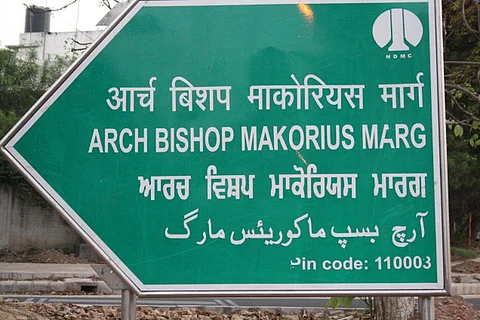
- Destinations
- Experiences
- Stay
- What's new
- Celebrating People
- Responsible Tourism
- CampaignsCampaigns
- Subscribe
- Buy Now

There is a quiet road in the diplomatic district of downtown Delhi that is rarely mentioned outside of official announcements and municipal maps. However, Prime Minister Narendra Modi's recent visit to Cyprus and his bestowing of the Grand Collar of the Order of Makarios III, the nation's highest civilian accolade, has thrown a light on the Archbishop Makarios Marg and brought it right under the public eye. A long-forgotten period of Indo-Cypriot relations and a rich history rooted in mutual diplomatic respect are brought to the public's attention as this significant road receives renewed attention.
Archbishop Makarios Marg, named after Cyprus’s first President and leader Archbishop Makarios III, runs through Delhi’s central administrative region, on the flanks of which are several embassies and government buildings. The road is given to commemorate a significant historical connection only few people know about: Makarios III visited India multiple times and was deeply admired by Indian leaders of the time, including Jawaharlal Nehru and Indira Gandhi. His status as both a political figure and a religious head resonated strongly with India’s own secular, democratic ideals.
Interestingly, this nomenclature was part of a broader diplomatic tradition. Just as India named a road after the Cypriot leader, Cyprus, in return, honoured India by naming a prominent street in Nicosia after Father of the Nation, Mahatma Gandhi. This reciprocal act with political connotations underscores the understanding that has long existed between the two nations, especially in the context of the Non-Aligned Movement, of which both were early and active members.
On August 25, 2023, during his visit to Cyprus, PM Modi was awarded the Grand Collar of the Order of Makarios III. This recognition, conferred by President Nikos Christodoulides, is the highest civilian honour in Cyprus and is named after the very figure after whom the Delhi road is titled. The moment marked a high point in bilateral relations and has inadvertently cast attention back on the nearly-forgotten street in Delhi, named decades ago in honour of a friendship between nations.
The honour is not simply a symbolic act; it reflects back on India’s growing stature in global diplomacy and its continuing emphasis on historical alliances. It has also prompted civic interest in the legacy of Archbishop Makarios and the deeper stories embedded within India’s urban spaces with which the area that’s called Central Delhi brims.
Despite being centrally located, Archbishop Makarios Marg remains lost to everydayness and toil. There are no plaques explaining the origin of the name, no statues or murals—just a road sign that, until now, meant little to the average Delhiite. Though that is the case with most other streets in Central Delhi bearing various other names reading which take you back to social sciences books from school. But behind its quiet appearance lies a profound narrative of resistance, postcolonial identity, and international solidarity.
Makarios III, a staunch anti-colonial figure who led Cyprus to independence from British rule in 1960, was admired across the developing world. His firm stance on sovereignty and his role in unifying Cyprus under a single national identity echoed India’s own struggles with partition and decolonisation. Naming a Delhi street after him was not merely a gesture of friendship, but an ideological kinship with another former colony striving to define its democratic path. It was also a time when decolonised countries were coming together in terms of policies, ideologies, architecture and urban landscape.
In an age when street names often serve as rigorously contested and thoroughly heated political battlegrounds, Archbishop Makarios Marg stands out as a reminder of shared histories and international friendships which must be preserved and not tampered with. It reflects a time when diplomacy extended beyond embassies and into urban spaces—when the naming of a road could affirm the values of freedom, sovereignty, and mutual respect in contrast to being lost to communally charged politics.
Today, as more eyes turn to this quiet street in Lutyens’ Delhi, perhaps it is time to not only remember the man it is named after, but also to reconsider how public memory is shaped through geography. In revisiting Archbishop Makarios Marg, we are also revisiting the spirit of Indo-Cypriot camaraderie that continues to thrive across decades and geographies.
(With inputs from various sources.)
